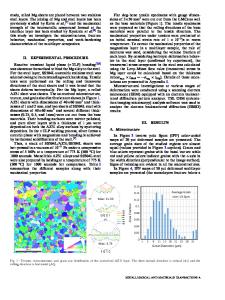Mechanical Properties Involved in the Micro-forming of Ultra-thin Stainless Steel Sheets
- PDF / 4,372,794 Bytes
- 14 Pages / 593.972 x 792 pts Page_size
- 71 Downloads / 340 Views
UCTION
DUE to the trend of miniaturization in high technology fields like micro-electronics, medicine appliances, and energy, ultra-thin metallic sheets are widely used, particularly stainless steel, due to its excellent corrosion resistance, high strength, and good formability,[1,2] and Cu alloys.[3] For instance, the austenitic ultra-thin stainless steel sheets including AISI 304 are currently used for the manufacturing of mobile phone parts, energy devices like film heater, and micro medical devices.[4,5] Fabrication processes of small parts, i.e., having dimensions between 2 and 20 mm,[6] with thin sheet metal, offer attractive characteristics of low production cost and low energy consumption compared to those of larger parts.[7] The thickness of the material is what determines whether it is called ultra-thin sheet, thin sheet, or even plate. From an industrial point of view, an ultra-thin sheet has usually a thickness ranging from 13 lm up to 200 lm.[8,9] This division depends in fact on the ratio N ¼ dt between the thickness t and the average grain size d. By investigating the behavior of pure copper with a thickness ranging from 500 lm down to 10 lm, Hoffmann et al.[10] showed that the stress–strain curves for a sheet thickness of 200 lm (N ’ 10) and 500 lm
CONG-HANH PHAM, Post-doctorate, and SANDRINE THUILLIER and PIERRE-YVES MANACH, Professors, are with the LIMATB, Universite´ de Bretagne-Sud, EA 4250, 56100 Lorient, France. Contact e-mail: [email protected] Manuscript submitted June 27, 2014. METALLURGICAL AND MATERIALS TRANSACTIONS A
(N ’ 25) have similar shape and level. Specimens thicker than 200 lm were classified as macro scale specimens, while specimens thinner than 200 lm, from 100 lm and N ’ 3:3 down to 10 lm and N ’ 0:3, exhibited a lower stress level typical of ultra-thin sheet. These results are similar to those presented by Furushima et al.[11,12] for pure copper, with t
Data Loading...











